R (Small
Washington Tablet)
6. The Chinese structure is
beginning with Spica (*202), where Porrima (*191) and the
star at the neck of
Virgo - Zaniah (η) - will belong in the past:
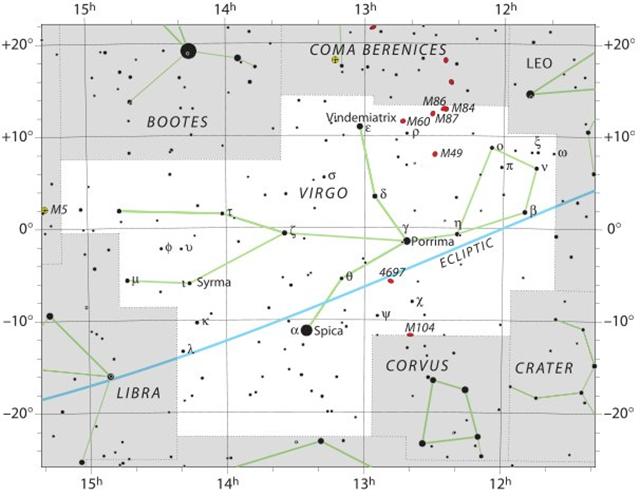
And the last one of
the 28 Chinese
stations was defined from Gienah (γ Corvi)
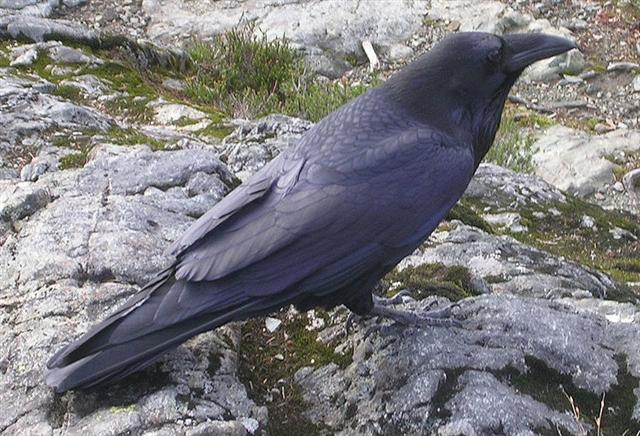
located at the equinox in September
and 20 days after Alkes in the dry Crater constellation.
|
28 |
*17 |
1 |
*348 |
28 |
|
Gienah (γ) |
Spica (α) |
Gienah (γ) |
|
Sept 22 (265, *185) |
Oct 9 (*202, 282) |
Sept 22 (265, *185) |
|
*366 |

This (the September equinox)
was also the right ascension day *185 where
Zaniah - the 'Corner' in Virgo
- was located:
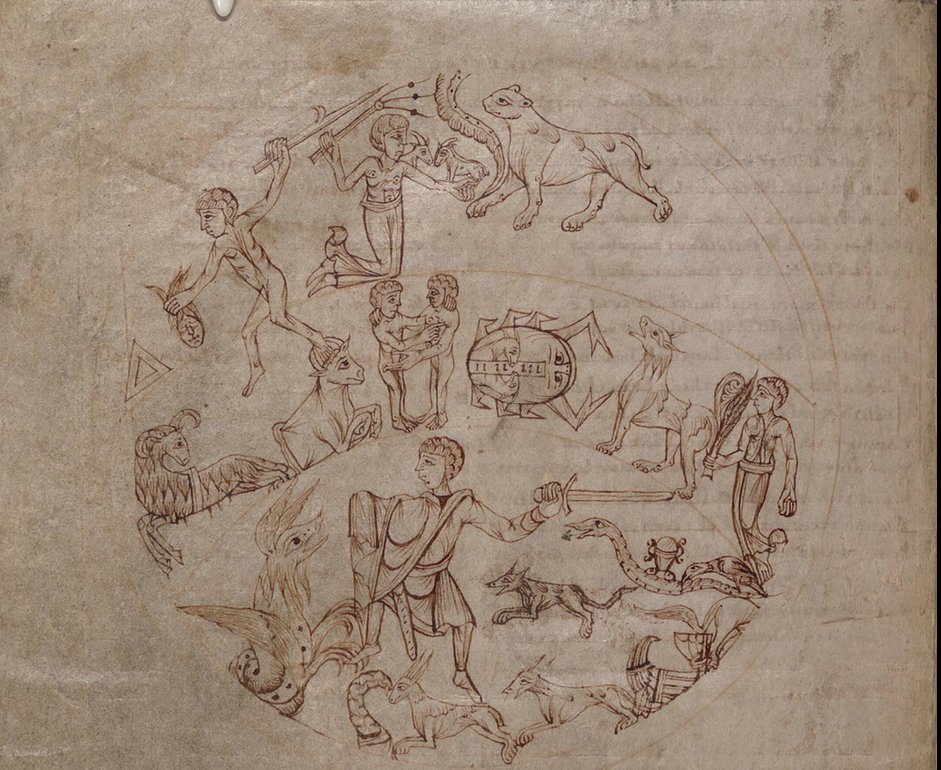
The contraction (>) caused by such
a corner as Zaniah (γ Virginis) might have induced the creator of the sky map above - with the great figure of Orion in the center
apparently pushing up the ecliptic plane - to illustrate a Sign
of >
between the the Tail of Raven and Virgo.
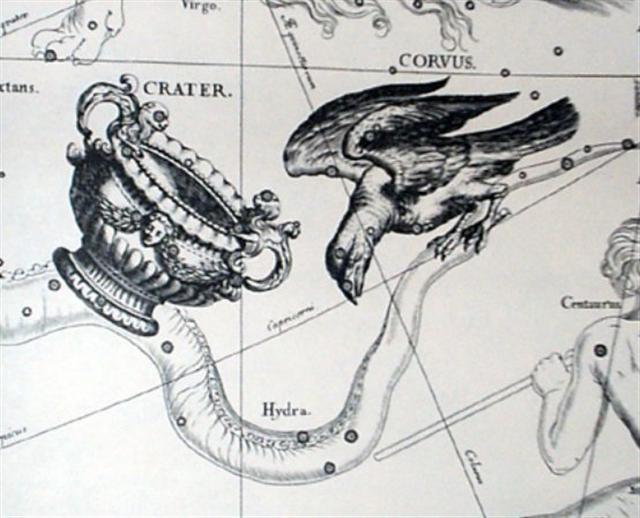

|
*17 |
1 |
*348 |
28 |
|
SPICA (α) |
GIENAH (γ Corvi)
Zaniah (γ Virginis) |
|
Oct 9 (*202, 282) |
Sept 22 (265, *185) |
|
348 'happens to be' the number of glyphs
on side b of the C tablet. And when the Sun reached the
Mouth of the Southern Fish (Piscis Austrinus - or
Australis) - Fum-al-Samakah, (β
Piscium), - this was *348 right ascensuion days
after 0h at Sirrah in the Andromeda constellation. |
The Sign of contraction (>) can be perceived also in the
constellation of Pisces, this one evidently floating on the
surface of the Sea and anchoraged to the Neck of Cetus by way of
Al-risha (the Knot), α Piscium.
... This [σ
Sagittarii] has been identified with Nunki of the
Euphratean Tablet of the Thirty Stars, the Star of the
Proclamation of the Sea, this Sea being
the quarter occupied
by Aquarius, Capricornus, Delphinus, Pisces, and Pisces
Australis. It is the same space in the sky that Aratos
designated as Water
...

At
the northern autumn equinox in September the 'butterfly' (te pepe)
was moving (kua rere):
 |
 |
 |
 |
 |
|
Aa8-55 |
Aa8-56 |
Aa8-57 |
Aa8-58 (→ 8 * 58
= 464) |
Aa8-59 |
| ki te henua - ki
te ragi |
kua heu ia - kua
rere ki te pepe |
mai tae ia ki te
nuku - honu |
kua vero ia |
ki te honu e kau
te honu |
|
Sept 21
(264) |
ZANIA
(η Virginis)
GIENAH
(γ Corvi)
Equinox |
*186 |
*4 +
*183
→ *227 - *41
+ *1 |
*188 |
|
Pepe. 1. A sketch. 2. Bench, chair,
couch, seat, sofa, saddle; here pepe, mau
pepe, to saddle; noho pepe, a tabouret.
Pepepepe, bedstead. 3. Pau.: butterfly. Ta.:
pepe, id. Mq.: pepe, id. Sa.: pepe,
id. Ma.: pepe, a moth; pepererau, fin,
Mgv.: pererau, wing. Ta.: pereraru,
id. Ma.: parirau, id. Harepepe, kelp.
Here pepe, to saddle. Churchill. Sa.: pepe,
a butterfly, a moth, to flutter about. Nukuoro, Fu.,
Niuē, Uvea, Fotuna,
Nuguria, Ta., Mq.: pepe,
a butterfly. Ma.: pepe,
a grup, a moth; pepepepe,
a butterfly; pepeatua,
a species of butterfly. To.: bebe,
a butterfly. Vi.: mbèbè,
a butterfly. Rotumā: pep,
id. Churchill 2. Mq.: Pepepepe, low,
flat. Ha.: pepepe, id. Churchill. |
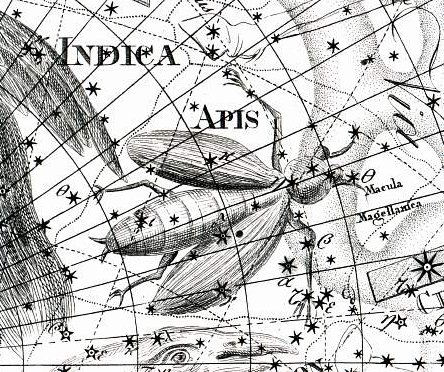
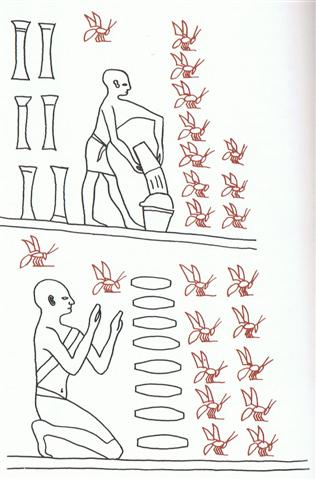
|
 |
*6
|
 |
 |
*227
→ π |
 |
|
Aa8-58 (→ 8 * 58
= 464) |
Aa8-64 (664 +
649) |
Aa8-65 (1314 →
182) |
( → *194 + *227 + *1) |
|
kua vero ia |
kua mata hihi
rarua mai |
ki te honu |
kua tuku ki to mata -
ki tona tukuga |
|
*4 +
*183
→ *227 - *41
+ *1 |
*193 =
*10 + *183
→ March
31 (Sept 30 - 183)
→ 90 = 3 *
91 - 183 |
Oct 1
(274, *194)
ALIOTH → ι
= ε
Ursae Majoris
η Andromedae (*11.4) |
May 16 (500 + 1, 136)
ALCYONE (*56) |
|
... A vestige of the practice of
putting the king to death at the end of a year's reign
appears to have survived in the festival called
Macahity, which used to be celebrated in Hawaii
during the last month of the year. About a hundred years
ago a Russian voyager described the custom as follows:
'The taboo Macahity is not unlike to our festival
of Christmas. It continues a whole month, during which
the people amuse themselves with dances, plays, and
sham-fights of every kind. The king must open this
festival wherever he is. On this occasion his majesty
dresses himself in his richest cloak and helmet, and is
paddled in a canoe along the shore, followed sometimes
by many of his subjects. He embarks early, and must
finish his excursion at sunrise. The strongest and most
expert of the warriors is chosen to receive him on his
landing. The warrior watches the canoe along the beach;
and as soon as the king lands, and has thrown off his
cloak, he darts his spear [vero] at him, from a
distance of about thirty paces, and
the king must either catch
the spear in his hand, or suffer from it: there is
no jesting in the business. Having caught it, he carries
it under his arm, with the sharp end downwards, into the
temple or heavoo ...
Vero.
To throw, to hurl (a lance, a spear). This word was
also used with the particle kua preposed: koía
kua vero i te matá, he is the one who threw the
obsidian [weapon]. Verovero, to throw, to hurl
repeatedly, quickly (iterative of vero). Vanaga.
1. Arrow, dart, harpoon, lance, spear, nail, to
lacerate, to transpierce (veo). P Mgv.: vero,
to dart, to throw a lance, the tail; verovero,
ray, beam, tentacle. Mq.: veó, dart, lance,
harpoon, tail, horn. Ta.: vero, dart, lance. 2.
To turn over face down. 3. Ta.: verovero, to
twinkle like the stars. Ha.: welowelo, the light
of a firebrand thrown into the air. 4. Mq.: veo,
tenth month of the lunar year. Ha.: welo, a month
(about April). Churchill. Sa.: velo, to cast a
spear or dart, to spear. To.: velo, to dart. Fu.:
velo, velosi, to lance. Uvea: velo,
to cast; impulse, incitement. Niuē:
velo, to
throw a spear or dart. Ma.: wero,
to stab, to pierce, to spear. Ta.: vero,
to dart or throw a spear. Mg.: vero,
to pierce, to lance. Mgv.: vero,
to lance, to throw a spear. Mq.: veo,
to lance, to throw a spear. Churchill 2.
|

|
 |
*18 |
 |
 |
|
Aa8-66
(1315) |
→ 8 * 84
= 14 * 48 weeks |
Aa8-85
(664 + 670 = 1334) |
|
kua
mau te manu - i to ika |
ki te henua |
- |
|
MINELAUVA (*195)
Oct 2
(275) |
*213
ALKES |
Κ
VIRGINIS (*214)
Oct 21
(294) |
|
"Aug 22
(234, *154) |
"Sept 10
(253, *173) |
|
"Febr 21
(457 - 41 = 416, 92 - 41 = 51 = 234 - 183)
*336
↔
416 - 80
→ 48
weeks (Dec 2, 336) |
April 20
(110, *30) |
"March 11 (51 + 19 = 70 = 253 - 183)
*355 = *336 + *19
→
Dec 21 (355) |
|
... In 1638 Johannes Holwarda determined a
period of the star's reappearances, eleven months; he is often
credited with the discovery of Mira's variability. Johannes
Hevelius was observing it at the same time and named it 'Mira'
(meaning 'wonderful' or 'astonishing,' in Latin) in 1662's
Historiola Mirae Stellae, for it acted like no other known
star. Ismail Bouillaud then estimated
its period at 333 days, less than one day off the modern
value of 332 days, and perfectly forgivable, as Mira is known to
vary slightly in period, and may even be slowly changing over
time ... |
... From a religious point of view, the high
regard for flies, whose increase or reduction causes a similar
increase or reduction in the size of the human population, is
interesting, even more so because swarms of flies are often a
real nuisance on Easter Island, something most visitors have
commented on in vivid language. The explanation seems to be that
there is a parallel relationship between flies and human souls,
in this case, the souls of
the unborn. There is a widespread belief throughout
Polynesia that insects are the embodiment of numinous beings,
such as gods or the spirits of the dead, and this concept
extends into Southeast Asia, where insects are seen as the
embodiment of the soul
...
|
JULY 19
(200) |
20 (*121) |
 |
 |
|
Ga5-10 (→ 5
`* 10 = 50) |
Ga5-11 (121) |
|
PÁLIDA
(Pale) = δ
Crucis
(184.6),
MEGREZ
(Root of the Tail) =
δ
Ursae Majoris
(184.9) |
Hasta-13 (Hand)
/
Chariot-28 (Worm)
GIENAH (Wing) = γ Corvi (185.1),
ε Muscae (185.2),
ζ
Crucis (185.4), ZANIAH (Corner) =
η
Virginis
(185.9)
*144.0 = *185.4 - *41.4 |
|
Sept 21
(*184) |
EQUINOX |
|
°Sept
17 (*180) |
18 (261 → 9 * 29) |
|
'Aug 25 (*157 → π / 2) |
26 (238) |
|
"Aug 11 (*143) |
12 (224) |
|
... In
September 21 (264 = 80 + 184) the Sun would be (both
when rising and when descending, both at noon and at
midnight) at the line between δ Ursae Majoris and δ
Crucis ... |
And we have
earlier discovered that the same
viri glyph returned *49 right ascension nights (glyphs) later.
Seemingly in order for the Golden Age butterfly (pepe) to
make landfall where the Full Moon would reach the culmination
line connected with Acrux, and the Sun therefore reach the
culmination line connected with Sirrah:
|
SEPT
7 (250 = 200 + 50) |
8
(*171) |
9 |
 |
 |
 |
|
Ga7-1 (250 - 80
= 170) |
Ga7-2 |
Ga7-3 |
|
NUSAKAN (Pauper's Bowl) = β Cor. Bor. (234.0),
κ¹ Apodis (234.3), ν Bootis (234.7), ζ Librae
(234.9) |
θ Cor. Borealis (235.3), γ Lupi (235.6),
GEMMA = α Cor.
Bor., ZUBEN ELAKRAB = γ Librae, QIN = δ Serpentis, ε Tr. Austr.
(235.7),
μ Cor. Borealis (235.8), υ Librae (235.9)
SIRRAH (α ANDROMEDAE)
|
φ Bootis (236.2), ω Lupi, τ Librae (236.3), ψ¹
Lupi (236.7), ζ Cor. Borealis (236.9) |
|
Nov
10 (314 → π) |
11 (*235) |
12 |
|
°Nov 6 (310) |
7
(*231) |
8 |
|
'Oct
14 (287 = 314 - 27) |
15
(*208 = *235 - *27) |
16 |
|
"Sept 30 (273 = 314 - 41) |
"Oct
1 (224 + 50) |
2
(*195) |
|
... In other words, the ancient Druidic religion
based on the oak-cult will be swept away by
Christianity and the door - the god Llyr - will
languish forgotten in the Castle of Arianrhod,
the Corona Borealis. This helps us to
understand the relationship at Rome of Janus and
the White Goddess Cardea who is ... the Goddess
of Hinges who came to Rome from Alba Longa. She
was the hinge on which the year swung - the
ancient Latin, not the Etruscan year - and her
importance as such is recorded in the Latin
adjective cardinalis - as we say in
English 'of cardinal importance - which was also
applied to the four main winds; for winds were
considered as under the sole direction of the
Great Goddess until Classical times ... |
|
IDEALLY
CLOSE TO THE FULL MOON: |
|
MARCH 9 (68 = 250 - 182) |
10
(*354 = *171 + *183) |
11 |
|
No star listed (52) |
ψ
Persei (53.1)
ACRUX (α
CRUCIS) |
δ
Persei (54.7) |
|
May
12 (132) |
13
(*53) |
14 |
|
°May
8 (128) |
9
(*49) |
10 |
|
'April 15 |
16
(471 = 288 + 183) |
17
(107) |
|
"April 1 (91) |
2
(*377 = *194 + *183) |
3 |
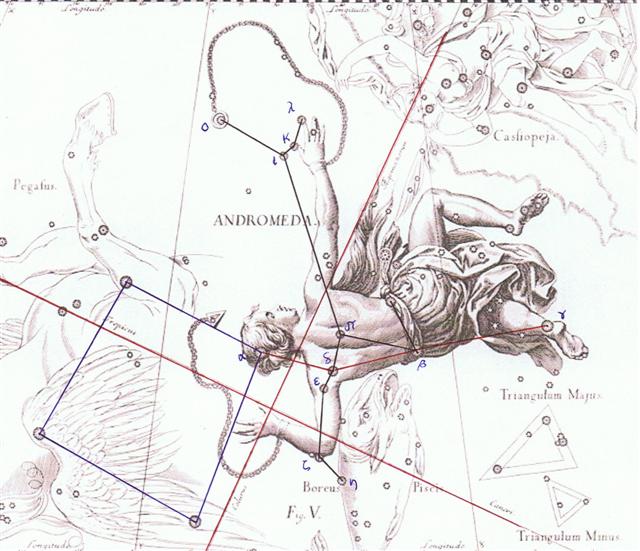
The Monarch, King (Tree), type of butterfly is
remarkably capable of
fluttering like a bird over very long distances. It was
all about the fate of the King, around which everything
else revolved:
... I also learned that the kings
embodied the ceiba at the moment it flowers to yield the
sak-nik-nal, the 'white flowers', that are the
souls of human beings. As the
trees flowers to reproduce itself, so the kings flowered
to reproduce the world
...
... Nevertheless, by virtue of a
series of spectacular coincidences, Cook made a
near-perfect ritual exit on the night of 3 February. The
timing itself was nearly perfect, since the Makahiki
rituals would end 1 February (±1 day), being the 14th
day of the second Hawaiian month [Kau-lua].
This helps explain
Mr. King's entry for 2
February in the published Voyage: 'Terreoboo [Kalaniopu'u]
and his Chiefs, had, for some days past, been very
inquisitive abouth the time of our departure' - to which
his private journal adds, '& seem'd well pleas'd that it
was soon'. Captain Cook, responding to Hawaiian
importunities to leave behind his 'son', Mr. King
[sic!], had even assured Kalaniopu'u and the high
priest that he would come back again the following year.
Long after they had killed him, the Hawaiians continued
to believe this would happen ...
... Several of the early missionaries comment with a
fine sense of humor upon the mistake the islanders made
in calling the cow when first seen a bird. This is the
word which led the good missionaries into the error of
their own ignorance. Manu is as wholesale in its
signification as our word animal, it is generic. In the
paucity of brute mammalia the first missionaries found
this general term most frequently used of birds, and it
was their and not a Polynesian mistake to translate
manu into bird. In the material here collected it
will be seen that the significations animal and bird are
widely extended. In the Paumotu
insects are
included; the same is true of Mota, where
manu signifies beetle as well as bird. Nor is its
applicability restricted to earth and air; it reaches
into the sea as well. Samoa uses i'amanu
(fish-animal) for the whale ...
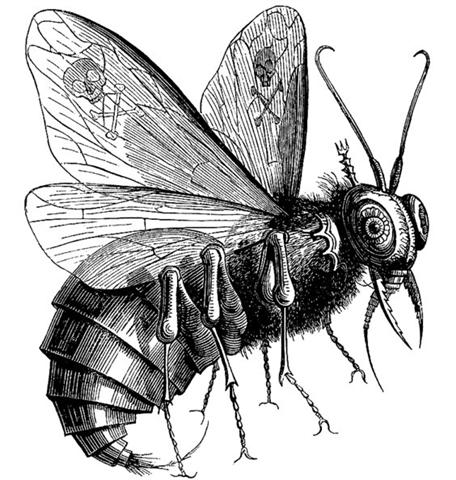
|
















